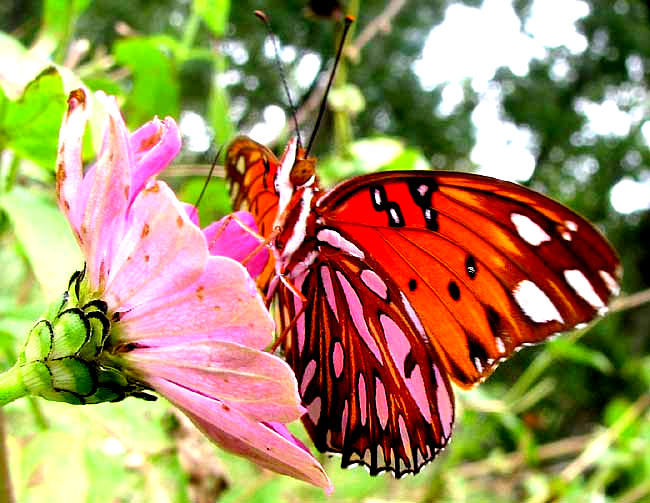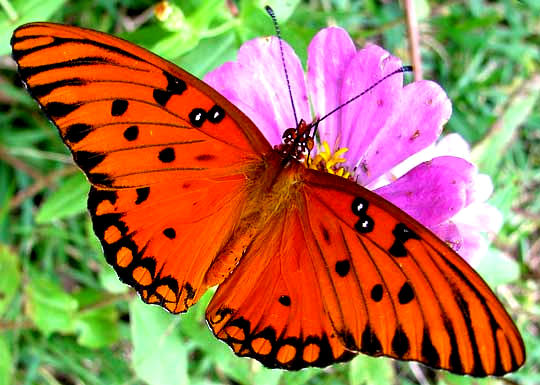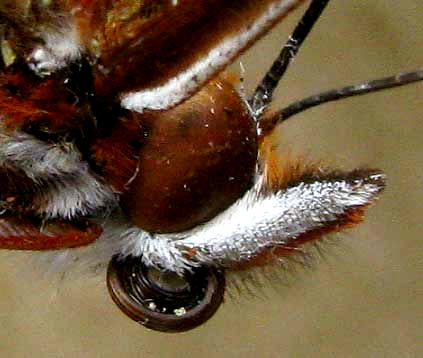Excerpts from Jim Conrad's
Naturalist Newsletter

from the October 18, 2009 Newsletter, from near Natchez, Mississippi
ONE-WAY GULF FRITILLARIES
Here near Natchez during the past warm, rainy week the only brightly colored, medium-size butterfly I saw was the one shown above.
That's the Gulf Fritillary, AGRAULIS VANILLAE, on one of Karen's fading zinnias. In this area those elongate, white, black-bordered splotches on the orange wings' undersides are shared by no other species. A view from the top is seen below:

Gulf Fritillaries are distributed throughout South and Central America, all through Mexico, and well into the US. Its occurrence in the US is fascinating: During the winter about the only places Gulf Fritillaries are found in the US are southern Florida and southern Texas. In spring they migrate northward and by the end of summer they may be seen as far north as North Dakota. A map showing where the species has been sighted is at https://www.butterfliesandmoths.org/species/Agraulis-vanillae.
But, when winter comes, all Gulf Fritillaries wherever freezing temperatures occur... die. Usually that means that all across the US they die, except in southern Florida and southern Texas. They do not leave behind eggs and pupae that survive the cold. Therefore, the Gulf Fritillary's yearly movement isn't like the Monarchs round-trip journey because it's one way. The next spring, once again individual Gulf Fritillaries begin winging northward from southern Florida, southern Texas and Mexico on their one-way trip northward.
During my hermiting days near Natchez I didn't see Gulf Fritillaries during the spring or summer. Twice, however, I mentioned them in my Newsletters, both in October editions.
Evolutionary biologists have a hard time figuring out how the Gulf Fritillary's seasonal movement evolved. Certainly the behavior gives the species an advantage in expanding its distribution northward as global warming continues, but it's hard to see how this predisposition could have been programmed into the species' DNA. Whatever the cause of its yearly northward wanderings, you who live just beyond the species' normal distribution might start keeping an eye open for them.
Gulf Fritillary larvae feed on passionflowers, verbenas, lantanas, phlox and other species. Their favorite hosts are passionflowers, though.
from the October 24, 2004 Newsletter, issued from near Natchez, Mississippi:
FRITILLARY CHRYSALIS
 Here we still have butterflies galore. In fact, while I was away my Natchez neighbor Karen sent a picture of a butterfly chrysalis she'd found dangling from a nail jutting from a barn wall. You'll remember that a chrysalis (pronounced KRISS-uh-liss) is the resting stage formed by a caterpillar before it metamorphoses into a butterfly. That's Karen's picture at the right.
Here we still have butterflies galore. In fact, while I was away my Natchez neighbor Karen sent a picture of a butterfly chrysalis she'd found dangling from a nail jutting from a barn wall. You'll remember that a chrysalis (pronounced KRISS-uh-liss) is the resting stage formed by a caterpillar before it metamorphoses into a butterfly. That's Karen's picture at the right.
From that chrysalis emerged an orangish butterfly of the species most commonly seen flitting about my remaining morning glories right now, the Gulf Fritillary, AGRAULIS VANILLAE. If you look at Karen's picture you'll see that the chrysalis is curved and warty in a curious way, with mottled brown colors. This wonderful camouflage causes the chrysalis to look like one of the abundant dried-up leaves lying all over the place at this time of year. The whole thing is about 1-1/8 inch long (28 mm).
from the November 18, 2012 Newsletter issued from the valley of the Dry Frio River in northern Uvalde County, southwestern Texas, on the southern border of the Edwards Plateau; elevation ~1750m (~5750 ft); N29.62°, W99.86°; USA
A FRITILLARY'S LABIAL PALPS
Below you can see the labial palps on a Gulf Fritillary:

The coiled, dark brown thing at the bottom is the strawlike proboscis through which nectar is drunk. The large, brown, spherical item above it is one of the butterfly's compound eyes, and the two black, slender items at the picture's top, right are antennae. The mostly white, fuzzy part at the picture's bottom, right is one of the labial palps. There's another palp on the other side of the butterfly's head. The palps' hairs are sensitive to touch and other stimuli. Basically they help the insect figure out what's good food and what's not.